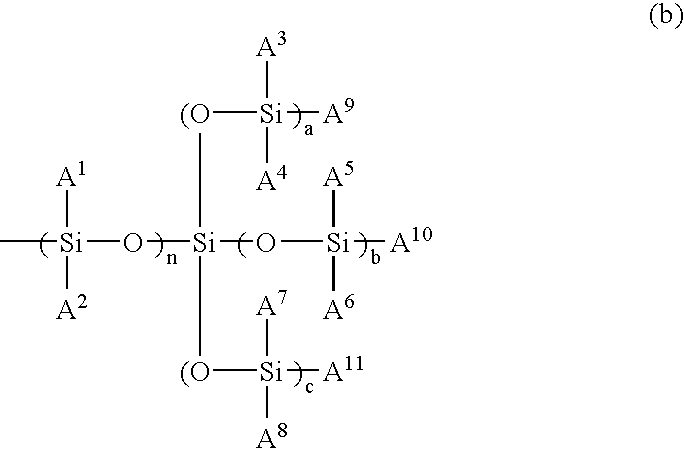Monomer, polymer, and ocular lens and contact lens each obtained therefrom
a technology of ocular lenses and contact lenses, which is applied in the field of monomers and polymers, can solve the problems of insufficient compatibility and achieve the effect of high oxygen permeability and sufficient compatibility
- Summary
- Abstract
- Description
- Claims
- Application Information
AI Technical Summary
Problems solved by technology
Method used
Image
Examples
example 1
[0062](1) 30 g (89 mmol) of 3-(glycidyloxypropyl)-1,1,1,3,5,5,5-hexamethyltrisiloxane, 90 g of 2-methoxyethanol and 1.14 g (9 mmol) of tetracyanoethylene (TCNE) were added to a 200 mL eggplant type distillation flask and the mixture was stirred for 3 hours, after which it was allowed to stand overnight at room temperature. After the reaction was completed, the solvent was removed using an evaporator. The proton nuclear magnetic resonance spectrum of the liquid that was obtained was determined and analyzed. As a result, peaks were detected in the vicinity of 0 ppm (3H), in the vicinity of 0.1 ppm (18H), in the vicinity of 0.4 ppm (2H), in the vicinity of 1.5 ppm (2H), in the vicinity of 2.6 ppm (1H), in the vicinity of 3.3 to 3.7 ppm (13H) and in the vicinity of 3.9 ppm (1H). From these findings, it was confirmed that it was a mixture of the compounds represented by formulas (M1) and (M1′) below. On the basis of the GC peak area ratios, the (M1) / (M1′) ratio was 85 / 15.
[0063][0064](2) ...
example 2
[0066]Synthesis was performed in the same way as in Example 1 using 2-(2-methoxyethoxy)ethanol instead of 2-methoxyethanol and a silica gel column instead of distillation under reduced pressure as the purification method. The proton nuclear magnetic resonance spectrum of the liquid that was obtained was determined and analyzed. As a result, peaks were detected in the vicinity of 0 ppm (3H), in the vicinity of 0.1 ppm (18H), in the vicinity of 0.4 ppm (2H), in the vicinity of 1.5 ppm (2H), in the vicinity of 1.9 ppm (3H), in the vicinity of 3.3 ppm (5H), in the vicinity of 3.4 to 3.7 ppm (12H), in the vicinity of 4.2 ppm (0.1H), in the vicinity of 5.1 ppm (0.9H), in the vicinity of 5.5 ppm (1H) and in the vicinity of 6.1 ppm (1H). From these findings, it was confirmed that it was a mixture of the compounds represented by formulas (M3) and (M3′) below. On the basis of the GC peak area ratios, the (M3) / (M3′) ratio was 86 / 14.
[0067]
example 3
[0068](1) 50 g (0.44 mol) of allyl glycidyl ether, 100 g (3.12 mol) of methanol and 5.61 g (0.044 mol) of tetracyanoethylene were added to a 300 mL eggplant type distillation flask and the mixture was stirred for 3 hours at room temperature, after which it was allowed to stand overnight. After the reaction was completed, the solvent was removed using an evaporator and the liquid that was obtained was purified by distillation under reduced pressure. The proton nuclear magnetic resonance spectrum of the liquid that was obtained was determined and analyzed. As a result, peaks were detected in the vicinity of 2.4 ppm (1H), in the vicinity of 3.4 ppm (7H), in the vicinity of 3.6 ppm (0.3H), in the vicinity of 3.9 ppm (2.7H), in the vicinity of 5.2 ppm (2H) and in the vicinity of 5.8 ppm (1H). From these findings, it was confirmed that it was a mixture of the compounds represented by formulas (M4) and (M4′) below. On the basis of the GC peak area ratios, the (M4) / (M4′) ratio was 73 / 27.
[00...
PUM
| Property | Measurement | Unit |
|---|---|---|
| half-life temperatures | aaaaa | aaaaa |
| weight % | aaaaa | aaaaa |
| time | aaaaa | aaaaa |
Abstract
Description
Claims
Application Information
 Login to view more
Login to view more - R&D Engineer
- R&D Manager
- IP Professional
- Industry Leading Data Capabilities
- Powerful AI technology
- Patent DNA Extraction
Browse by: Latest US Patents, China's latest patents, Technical Efficacy Thesaurus, Application Domain, Technology Topic.
© 2024 PatSnap. All rights reserved.Legal|Privacy policy|Modern Slavery Act Transparency Statement|Sitemap



